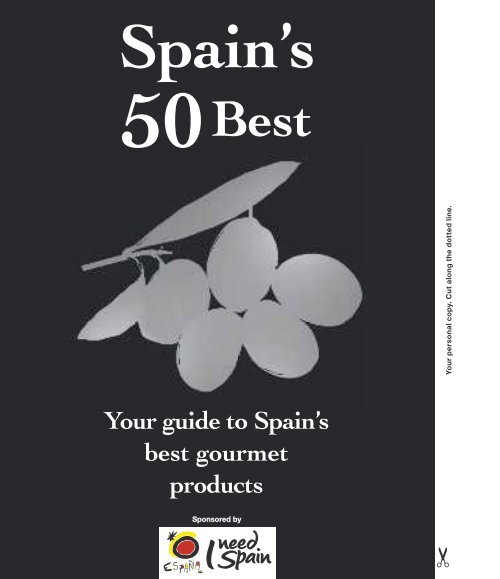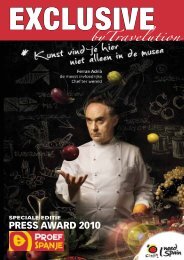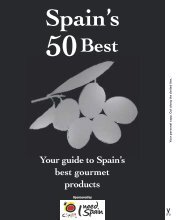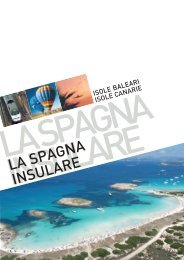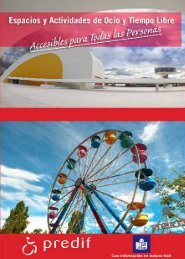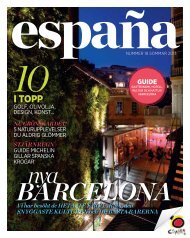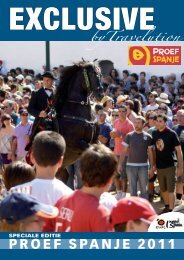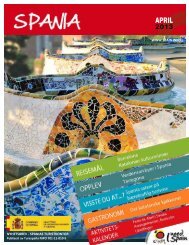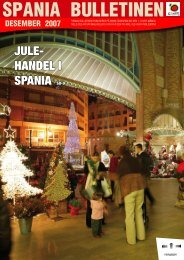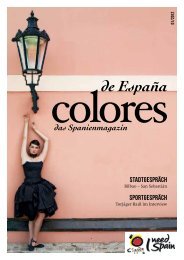Create successful ePaper yourself
Turn your PDF publications into a flip-book with our unique Google optimized e-Paper software.
<strong>Spain</strong>’s<br />
<strong>50</strong><br />
Best<br />
Your personal copy. Cut along the dotted line.<br />
Your guide to <strong>Spain</strong>’s<br />
best gourmet<br />
products<br />
Sponsored by<br />
1
Quality<br />
A traveller remembers coming home<br />
from the Balearic Islands with the typical<br />
ensaimada pastry, or a cold day on the<br />
plains of Castile in search of roast baby<br />
pig (cochinillo) or lamb (cordero). But<br />
<strong>Spain</strong>’s culinary wealth doesn’t stop<br />
there. It’s much, much greater.<br />
The country has become a gastronomic<br />
attraction for tourists, and this world<br />
–which continues to grow both here and<br />
overseas– has become something of a<br />
cultural and social science.<br />
When they sit down at table, foodloving<br />
visitors to <strong>Spain</strong> increasingly<br />
demand the best from the local food<br />
of the different areas they visit. They no<br />
longer seek just a good restaurant, but<br />
one that will also prepare food based on<br />
local produce. This culinary wealth allows<br />
tourists to plan their trips through <strong>Spanish</strong><br />
towns and cities not just on the basis of art<br />
and monuments, but also with an eye to<br />
the variety and quality of the food.<br />
<strong>Spain</strong>’s great diversity of climate and<br />
geography makes it possible to find some<br />
basic products of excellent quality, both<br />
from the land and the sea.<br />
Thanks to the different processes of<br />
canning and bottling, our products can be<br />
enjoyed everywhere –both in their place of<br />
origin and at home.<br />
For this reason, Turespaña is sponsoring<br />
this ‘Guide to the Top <strong>50</strong> <strong>Spanish</strong> Food<br />
Products’. The aim is to promote <strong>Spain</strong>’s<br />
food and drink even further.<br />
This is a selection of products from the<br />
country’s different Autonomous regions,<br />
which are more and more in demand from<br />
tourists to take back home with them to<br />
enjoy with their family or friends.<br />
These products have thus become<br />
the distinguishing characteristics of their<br />
respective Autonomous regions.<br />
Good examples of this are the wide<br />
range of extra virgin olive oils, the Ibérico<br />
pork products, and the many different<br />
cheeses made in all part of <strong>Spain</strong>.<br />
An important element in all this food<br />
and drink is the catalogue that lists the<br />
Denominación de Origen (D.O.) of<br />
each product –a prestigious classification<br />
awarded according to stringent criteria<br />
and which serves as a guarantee of<br />
quality– that is regulated by the Ministry<br />
of the Environment and Rural and<br />
Marine Affairs.<br />
Because of the large quantity and high<br />
quality of the basic products, it hasn’t been<br />
easy to decide on this Top <strong>50</strong> list. This is<br />
only a partial list, but everything that is on<br />
it deserves to be there.<br />
Joan Mesquida<br />
<strong>Spanish</strong> General Secretary for Tourism and Domestic Trade
Extra virgin olive oil<br />
1.aUboCassa eXtra virgin<br />
olive oil<br />
Bodegas Roda produces both wine<br />
and olive oil. Among the oils are two of<br />
excellent quality: the Dauro in L’Empordá<br />
(Catalonia) and the Aubocassa extra virgin<br />
olive oil, produced in Manacor (Majorca).<br />
The British paper The Independent has<br />
ranked Aubocassa one of the world’s<br />
ten best olive oils, while food critic Rafael<br />
García Santos calls it the summit of<br />
<strong>Spanish</strong> oils. It is made exclusively from the<br />
Arbequina olives at the farm in Manacor<br />
(Majorca) and is the result of the first cold<br />
pressing. It is yellowish in colour, with a<br />
greenish, opaque look due to the lack of<br />
filtering. The flavour is smooth with slightly<br />
bitter and spicy notes.<br />
www.roda.es✍<br />
2.rinCÓn de la sUbbétiCa<br />
eXtra virgin olive oil<br />
The Almazaras de la Subbética firm<br />
has ancient olive trees in<br />
the province of Córdoba<br />
producing the Picuda and<br />
Hojiblanca varieties. Outstanding<br />
among its extra virgin olive oils<br />
is the Rincón de la Subbética. It<br />
is 100 percent Hojiblanca, from<br />
the Priego de Córdoba D.O..<br />
It is also one of the oils that<br />
has won the most awards, both<br />
inside and outside <strong>Spain</strong>. The olives are<br />
harvested midway through the autumn. It<br />
is green in colour, with a bittersweet taste<br />
and a certain bite, and with suggestions of<br />
grass and almonds.<br />
www.almazarasdelasubbetica.es✍<br />
4
Extra virgin olive oil<br />
3. Castillo de Canena<br />
reserva familiar picual<br />
The Picual is the olive variety most<br />
cultivated in Andalusia, especially in<br />
the province of Jaén. The Castillo de<br />
Canena Reserva Familiar is the top of its<br />
Picual extra virgin olive oil range, and comes<br />
in numbered limited editions that have<br />
won its both domestic and international<br />
awards. The harvesting takes place in the<br />
mid-autumn, when the olives are optimally<br />
mature. After picking, they are cold-pressed,<br />
with controls of time and temperature, to<br />
extract the virgin extra olive oil. It is held in<br />
stainless steel vats at a constant temperature<br />
before bottling, with strict respect for the<br />
order of the different requests that have<br />
been made for this product.<br />
www.castillodecanena.com✍<br />
In the world of extra virgin olive oil, the tree is to the fruit<br />
what the fruit is to the tree. Thus the Latin aphorism olea<br />
prima omnium arborum est. For this reason, when we speak<br />
of extra virgin olive oil we refer exclusively to the oil that<br />
comes from the first cold pressing of the olives.<br />
Olives have been used since antiquity for just about<br />
everything: as food, in medicine, in religion... Currently<br />
they feature in the world of cosmetics.<br />
<strong>Spain</strong> has one of the largest areas in the world<br />
dedicated to the cultivation of olives, and is one of the<br />
biggest producers and defenders of extra virgin olive oil<br />
as en essential element in nutrition.<br />
There is a wide variety of olives. Among the leaders:<br />
Arbequina, Arbosana, Blanqueta, Castellana, Changlot<br />
Real, Cornicabra, Empeltre, Farga, Lechín de Granada,<br />
Lechín de Sevilla, Manzanilla Cacereña, Morisca, Morrut,<br />
Picual, Picudo, Sevillenca, Verdial de Badajoz, Verdial de<br />
Huévar, Verdial de Vélez Málaga...<br />
This great variety gives rise to a wide range of extra<br />
virgin olive oils. In the first group are the single-variety oil,<br />
the ones that use just one type of olive. Then come the<br />
blends, made from two or more varieties of olives, which<br />
lends a mix of aromas, flavours and textures.<br />
The <strong>Spanish</strong> market offers a wide range of extra virgin<br />
olive oil: Cortijo de Suerte Alta, Cladium, Jugo de Aceituna<br />
010 Adolfo Colección Cornicabra, Marqués de Valdueza,<br />
Abbae de Queiles, Castillo de Tabernas, Dintel...
4. la organiC oro eXtra<br />
virgin olive oil<br />
This is a totally ecological oil, both<br />
in the growing and production<br />
processes. . The Gómez de Baena<br />
family owns a grove of ancient olive<br />
trees on the La Amarilla farm<br />
(Ronda, Málaga province)<br />
that was a precursor to the<br />
La Organic operation. It is<br />
an association of growers<br />
who cultivate their old<br />
trees ecologically and in<br />
the traditional manner.<br />
This makes it possible to<br />
produce and sell the finest<br />
organic oil in Andalusia, La Organic Oro<br />
extra virgin. The original bottle –dark,<br />
square and squat– was designed by<br />
Philippe Starck. There are two varieties:<br />
La Organic Oro Intenso (100 percent<br />
Picudo olives) has floral and herbal<br />
aromas. La Organic Oro Suave is made<br />
from Picudo and Hojiblanca olives.<br />
www.laorganic.net✍<br />
5. arbosana la boella eXtra<br />
virgin olive oil<br />
La Canonja (Tarragona province)<br />
is home to the La Boella olive<br />
groves and press. This firm is an<br />
impor tant producer of extra virgin<br />
olive oil from Arbequina,<br />
Koroneiki and Arbosana olives.<br />
The Arbosana is one of the<br />
oldest in <strong>Spain</strong>, indigenous<br />
to Catalonia and close to<br />
extinction. La Boella is fighting<br />
for its preservation. This olive<br />
gives extraordinar y results<br />
because it adapts easily to<br />
intensive cultivation. The<br />
Arbosana extra virgin olive<br />
oil is the firm’s most emblematic<br />
product, harvested in December when<br />
the fruit has a low level of maturity.<br />
www.laboella.com✍<br />
6. Pago MarQUés de griñÓn<br />
oleUM artis eXtra<br />
virgin olive oil<br />
In the town of Malpica de<br />
Tajo (Toledo province),<br />
in the Dominio de<br />
Valdepusa area,<br />
there are some 100<br />
h e c t a r e s o f s e m i -<br />
intensive olive groves<br />
of the Arbequina and<br />
Picual varieties, both very<br />
common on the Iberian<br />
Peninsula. The Marqués de<br />
Griñón Oleum Artis in an<br />
estate-bottled extra virgin olive oil, a<br />
perfect blend of these two varieties.<br />
The olives are harvested at the best<br />
possible time, and once collected are<br />
immediately pressed with rigorous<br />
controls.Then the oil is filtered and kept<br />
in stainless steel vats until bottling.<br />
www.pagosdefamilia.com✍<br />
6
S<br />
TasTing spain<br />
aborea España (“Tasting <strong>Spain</strong>”)<br />
is the first private platform –now<br />
domestic but with international<br />
ambitions– to promote tourism and<br />
gourmet eating. It has the support of the<br />
Ministry of Industry, Tourism and Trade,<br />
and of the <strong>Spanish</strong> Tourism Institute.<br />
Among its more noteworthy projects are<br />
a study of gourmet tourism in the country<br />
today, the devising of action plans for<br />
designing innovative culinary experiences<br />
for tourists, the creation of “gourmet<br />
maps”, the organizing of a gourmet event<br />
featuring pintxos and tapas and to be<br />
called EXPOTAPA, and the promotion of<br />
established gourmet events.<br />
Its key aims are:<br />
• To lend gourmet dimensions<br />
to tourism products<br />
• To broaden the concept of gourmet<br />
tourism via a focus on <strong>Spain</strong>’s<br />
authentic regional cuisines<br />
• To link the primary sector (agriculture)<br />
to the tertiary or services sector (the<br />
hospitality industry)<br />
Saborea España is an association of four<br />
bodies involved in gourmet dining and<br />
tourism: the <strong>Spanish</strong> Hostelry Federation,<br />
the <strong>Spanish</strong> Association of Destinations for<br />
the Promotion of Gourmet Tourism (Euro-<br />
Toques), the European Chefs Organization<br />
(an association of Europe’s most prestigious<br />
chefs de cuisine), and the <strong>Spanish</strong><br />
Association of Chefs and Pastry Chefs.
Ibérico ham<br />
7. señorío de Montanera<br />
acorn-fed ibérico ham<br />
In the Extremadura region of<br />
western <strong>Spain</strong> there are large<br />
extensions of land given over<br />
to raising the Ibérico pig. The<br />
geography and climate are essential<br />
elements in hams yielded by these<br />
acorn-fed animals. The breeding,<br />
production and commercialisation of<br />
the acorn-fed Señorío de Montanera<br />
Ibérico pig is subject to the D.O.<br />
Dehesa de Extremadura. It begins with<br />
the selection of the best Ibérico pigs,<br />
which are raised in freedom and by<br />
the montanera process: in other words,<br />
through grazing in these special fields<br />
and eating acorns from the oak trees.<br />
The whole process –selection, salting,<br />
post-salting, drying and curing– is carried<br />
out by traditional craftsmanlike methods<br />
and is subject to the strictest control.<br />
www.senoriodemontanera.com✍<br />
8. FerMín acorn-fed ibérico ham<br />
In the small picturesque town of<br />
La Alberca (Salamanca province),<br />
Embutidos Fermín began as a small<br />
family business. Today it is a leader in<br />
the field of acorn-fed Ibérico ham,<br />
exporting it all over the world. There<br />
are three things that characterise this<br />
ham. One is the fact that it comes<br />
from pure Ibérico pigs that have been<br />
raised on a diet of natural grazing and<br />
acorns in Salamanca. Others of its hams<br />
come from pigs that have grazed in<br />
the oak forests of the Extremadura
Ibérico ham and other pork products<br />
and Andalusia regions. A second<br />
characteristic is the weather, which<br />
allows the hams to be perfectly dried<br />
and matured. The third is the natural<br />
curing by craftsmanlike methods.<br />
www.embutidosfermin.com✍<br />
9. CinCo Jotas acorn-fed<br />
ibérico ham<br />
A whole series of towns in the<br />
Sierra de Huelva region constitute<br />
the D.O. Jamón de Huelva. The Sánchez<br />
Romero Carvajal firm has been one of<br />
the leaders for over a century. Its most<br />
emblematic acorn-fed Ibérico ham is<br />
called Cinco Jotas. It doesn’t have the<br />
D.O. Jamón de Huelva, but it does come<br />
from free-range Ibérico pigs fed by the<br />
montanera method, and the production<br />
Ibérico ham is the jewel in the <strong>Spanish</strong> culinary crown. The<br />
qualification ‘acorn-fed Ibérico ham’ refers to the pig of the<br />
Ibérico race that is native to the Peninsula and ranges free<br />
in the fields. It eats the grass here and the acorns from cork<br />
oaks (called the montanera diet).<br />
The pigs classified as de cebo or de recebo are those<br />
whose diet and fattening has been rounded off with the use<br />
of fodder. They are of high quality but without reaching that<br />
of the ones that have been raised exclusively on acorns.<br />
The Ibérico pig develops a muscular mass, in this case on<br />
the hind legs, that contains a kind of fat that contributes to<br />
its quality and extraordinary flavour. The front legs weigh<br />
less but are also of excellent quality.<br />
The four Protected Denominations of Origin are:<br />
Guijuelo (Salamanca); Dehesa de Extremadura, Los<br />
Pedroches (Córdoba) and Jamón de Huelva.<br />
The breeding, preparation and curing of these different<br />
hams follows strict steps that yield unique products. An<br />
ideal way to consume ham is in thin slices sliced with a knife.<br />
Ham is also a fine ingredient in many recipes.<br />
The essential characteristic of the Ibérico products is<br />
that fatty marbling in the meat, the result of the diet of<br />
these free-range pigs: on the grazing land and on the acorns<br />
from the oaks trees. The fat lends a special texture and<br />
oiliness. Some experts believe that even the aroma of the<br />
meat varies from one growing area to another, depending<br />
on the amount of fat and its proximity to the bone.<br />
REAL JAMÓN is a new brand that guarantees the very<br />
best in Ibérico hams. (http://www.realjamoniberico.com/)
and curing process is carried out by<br />
craftsmanlike methods. It has an<br />
intense aroma, uniform colour<br />
–with the characteristic fatty<br />
marbling, a result of its unique<br />
diet– a velvety oiliness and a flavour<br />
with a unique personality.<br />
www.cincojotas.com✍<br />
10. CoVaP alta<br />
eXPresiÓn<br />
pure acorn-<br />
fed ibérico ham<br />
C OVA P ( S o c i e d a d<br />
Cooperativa Andaluza<br />
Ganadera del Valle<br />
de los Pedroches),<br />
produces excellent<br />
chacinas (cold cuts) of<br />
Pure Ibérico Pig. Among<br />
them is the acorn-fed ham<br />
classified as Alta Expresión, the<br />
firm’s top quality product. The<br />
Ibérico Puro de Bellota hams come<br />
from Ibérico pigs whose parents had 100<br />
percent Ibérico blood. There are strict<br />
controls on selection and production,<br />
including analysis of the percentages of<br />
oleic, linoleic, palmitic and stearic fatty<br />
acids; control of the maturing and aging<br />
period, which must be greater than 36<br />
months; and selection of the hams in the<br />
Alta Expresión class.<br />
www.covap.es✍<br />
11. señorío de Montanera<br />
salchichÓn<br />
Considered by some experts<br />
as the great salchichón of the<br />
Extremadura region, it comes from<br />
100 percent acorn-fed Ibérico pig.<br />
At Señorío de la Montanera, nothing<br />
goes to waste. The firm also has<br />
other products apart from hams. The<br />
ingredients in this salchichón are the<br />
lean meat of the pigs, along with part<br />
of the meat from the front and back<br />
legs. The ingredients are chopped up<br />
and mixed, seasoning is added (salt,<br />
pepper in grains or ground up, and<br />
other spices), followed by marination<br />
and the stuffing into natural casing.<br />
www.senoriodemontanera.com✍<br />
12. CoVaP lomito<br />
Following the acorn-fed cured<br />
Ibérico ham Alta Expresión, the<br />
next most distinguished product of<br />
the COVAP cooperative is the cured<br />
Ibérico pork cut known as Lomito<br />
de Presa. The lomito or “small loin”<br />
is not a traditional cured pork loin,<br />
but a cut taken from the richest and<br />
tenderest part near the shoulders, and<br />
is a favourite of the best chefs. The<br />
exclusive lomito is not yet a traditional<br />
cut of cured pork, but it soon will<br />
be. COVAP’s version is made from a<br />
select cut that is dressed, seasoned and<br />
packed in a traditional gut casing. It is<br />
dark red and streaky, with an exquisite<br />
aroma and texture. Each piece weighs<br />
between 600 and 800 grams.<br />
www.covap.es✍<br />
10
spanisH FOODs On THE WEB<br />
ANDALUSIA.- http://www.andalucia.org<br />
ARAGON.- http://www.turismodearagon.com<br />
ASTURIAS.- http://www.infoasturias.com<br />
BALEARIC ISLANDS.- http://www.illesbalears.es<br />
BASQUE COUNTRY.- http://www.euskaditurismo.net<br />
CANARY ISLANDS.- http://www.turismodecanarias.com<br />
CANTABRIA.- http://www.turismodecantabria.com<br />
CASTILE-LA MANCHA.- http://www.turismoCastilelamancha.com<br />
CASTILE & LEON.- http://turismoCastileyleon.com<br />
CATALONIA.- http://www.gencat.cat<br />
CEUTA.- http://www.ceuta.es<br />
EXTREMADURA.- http://www.turismoextremadura.com<br />
GALICIA.- http://www.turgalicia.es<br />
LA RIOJA: http://www.lariojaturismo.com<br />
MADRID.- http://www.turismomadrid.es<br />
MELILLA.- http://www.melillaturismo.com<br />
NAVARRE.- http://www.turismo.Navarre.es/esp/home<br />
REGION OF MURCIA.- http://www.murciaturistica.es<br />
REGION OF VALENCIA.- http://www.comunitatvalenciana.com<br />
TURESPAÑA. - http://www.spain.info<br />
MINISTRY OF THE ENVIRONMENT AND RURAL AND MARINE AFFAIRS<br />
(FOOD DIVISION).- http://www.alimentacion.es<br />
11
Sausages and meat products<br />
13. Joselito acorn-fed cured<br />
pork loin<br />
Joselito is a brand that stands for<br />
excellence in acorn-fed Ibérico pork<br />
products. Its hogs are raised in immense<br />
pastures through the north-western part of<br />
the Iberian Peninsula, and its famed natural<br />
drying sheds are located in Guijuelo, in the<br />
province of Salamanca. Only hand-picked<br />
acorn-fed Ibérico pork is used to make<br />
the cured pork loins. After cleaning and<br />
trimming, each piece is covered in salt,<br />
garlic and paprika. Next, the meat is packed<br />
in natural casing, smoked by wood and<br />
charcoal and cured until packing.<br />
www.joselito.com✍<br />
14. Frial ibérico supremas<br />
Frial, the company founded in 1 by<br />
Ramón Frial, is now a group of companies<br />
dedicated to the preparation of cured<br />
Ibérico pork products and cooked cold cuts,<br />
in Ciudad Rodrigo (Salamanca province)<br />
and Tres Cantos, near Madrid. The three<br />
key features of Frial’s Supremas are meat<br />
from the black Ibérico pig –cooked at a low<br />
temperature to conserve the natural taste,<br />
aroma, and tenderness– and strictly limited<br />
production. Tinned Ibérico pork Supremas is a<br />
unique product, one of the most famous from<br />
Frial. Made entirely of tongue and jowls, this<br />
cold cut is firm, juicy, pink, and gluten-free.<br />
www.grupofrial.com✍<br />
15. FeblaMe cured beef<br />
Feblame, S.L. is a family-owned processed<br />
meat company now in its third<br />
generation and under the management<br />
1
of Santiago Blanco. Its leading product is<br />
cecina or cured beef, and this local variety is<br />
made in the province of León. Cured beef has<br />
been made since antiquity, and its preparation<br />
was described in the first century of the<br />
Christian era. The same process is used today.<br />
The cuts are from the hindquarters (flank,<br />
sirloin, round, and shank) of beef that is at least<br />
five years old, from breeds native to Castile and<br />
León. The meat is salted and cured with smoke.<br />
The whole process is done by traditional<br />
means, and no preservatives or additives<br />
are used, so the flavour, aroma and texture<br />
are entirely natural.<br />
www.cecinadeleon.org✍<br />
16. el Zagal majorcan sausage<br />
made from black ibérico pig<br />
The El Zagal brand is used by<br />
the company founded in 10 by<br />
Francisco Tejedor García. It prepares<br />
Majorcan sobrasada sausage, in keeping<br />
with the standards of the D.O. Sobrasada<br />
de Mallorca. El Zagal makes a variety of<br />
sobrasada (as sausage, slices, in terrines,<br />
etc.), but its star product comes from local<br />
Ibérico black pigs who are fed a special diet.<br />
The meat is carefully selected, minced and<br />
spiced with paprika before being extruded<br />
as sausage and cured at length The result<br />
is a delicious soft and spreadable sausage,<br />
turned red by the paprika, with a complex<br />
and exquisite flavour.<br />
www.elzagal.com✍<br />
17. saénZ HoreCa vacuumpacked<br />
meats<br />
Sáenz Horeca has been in business<br />
for more than years. Its complete<br />
meat-producing operation offers the<br />
safest food of four kinds: beef, sheep,<br />
goat and pig. Its fresh meat products have<br />
been vacuum-packed and undergone<br />
rigorous micro-biological and chemical<br />
analyses. The uninterrupted cold chain<br />
guarantees the best colour, texture and<br />
flavour. In general these products go<br />
wonderfully well a good aged red or any<br />
of <strong>Spain</strong>’s appellation wines.<br />
www.saenzhoreca.com✍<br />
18. ganso ibériCo de deHesa<br />
cured duck magret<br />
Ganso Ibérico is a firm with long<br />
experience in all aspects of rural projects:<br />
natural, cultural and ethnographic. It is a pioneer<br />
in the ecological breeding of the Ibérico freerange<br />
goose in southern <strong>Spain</strong>. In its cured<br />
magret, the meat is similar to that of the Ibérico<br />
ham, with little water content, and is rich in<br />
monounsaturated fats, proteins and minerals.<br />
This is a very versatile meat with a surprising<br />
flavour, which should be eaten on its own, with<br />
some drops of extra virgin olive oil, or in salads<br />
or pastas. The ideal temperature for consuming<br />
it is around 20 degrees centigrade.<br />
www.gansoiberico.com✍<br />
1
Cheese<br />
19. Marantona manchego<br />
cheese<br />
La Casota is a family business that<br />
has been going for five generations.<br />
Its sheep graze in different parts of<br />
La Mancha, land that includes the<br />
remains of harvests, grape vine shoots,<br />
rosemary. The cheese factory boasts<br />
the latest hygienic processes and<br />
produces several types of cheeses (soft,<br />
semi-cured, cured, old, in oil). They also<br />
make goat cheese. Outstanding is the<br />
Marantona Manchego cheese, cured in<br />
natural caves and with the D.O. Queso<br />
Manchego. It comes from Manchega<br />
sheep’s milk, and is matured from<br />
eight to ten months. It has an intense,<br />
pleasant and persistent aroma.<br />
www.quesoslacasota.com✍<br />
20. don rebesino torta<br />
del casar<br />
There is a wide range of <strong>Spanish</strong><br />
14
The cheeses<br />
cheeses. Among the creamy ones<br />
perhaps the Torta del Casar is the<br />
strangest yet most representative,<br />
for its shape and texture and the<br />
way it is made. Quesería Ganadera<br />
To speak of cheese in <strong>Spain</strong> is to speak of one of the<br />
country’s most important food and culinary sectors.<br />
This culinary wealth has been reflected in <strong>Spanish</strong><br />
literature from the Golden Age to the present. It’s also<br />
seen in rhyming popular sayings like “con pan y vino se<br />
anda el camino” (with bread and wine we’ll get by) and<br />
“uvas, pan y queso saben a beso” (grapes, bread and cheese<br />
taste like kisses).<br />
The great diversity from north to south and east<br />
to west —not to mention the archipelagos— makes it<br />
possible to group them into different categories. Depending<br />
on the kind of milk used in their production, we can speak<br />
of goat, sheep and cow cheese, along with blends. As for<br />
the maturing and curing processes, they can be classified<br />
as soft, semi-cured, cured and old.<br />
As a general rule, in the Castilian regions and<br />
Extremadura the most common cheeses come from<br />
sheep; in Asturias and Galicia, from cows; in the Canary<br />
Islands, Murcia and Catalonia, from goats. There are<br />
different breeds in each of these three kinds of livestock,<br />
and this too is a factor in the characteristics of the<br />
different cheeses.<br />
These cheeses should usually be kept in a cool place —<br />
but never a refrigerator— and eaten at room temperature.<br />
Good country bread is the best thing to go with cheese.<br />
They are very nutritious and are high in saturated fats,<br />
and so should be consumed in moderation. They have high<br />
levels of calcium and other nutrients.<br />
1
S.L. was founded in 2005. It is an<br />
association of farmers whose cheese<br />
blends tradition and technology,<br />
where natural craftsmanship coexists<br />
harmoniously with research into milk<br />
products. Outstanding among its<br />
cheeses is the Torta del Casar Don<br />
Rebesino (D.O.P. Torta del Casar). It’s<br />
made exclusively with the raw milk of<br />
Merino and Entrefina sheep to which<br />
is added salt and vegetable rennet,<br />
and it matures for at least 60 days.<br />
The rennet used is obtained from the<br />
common cardoon flower.<br />
www.queseriaganadera.es✍<br />
21. la Peral cheese<br />
La Peral is a family-run cheese<br />
firm founded in 1 by Antonio<br />
León Álvarez. Since<br />
then it has been producing La<br />
Peral cheese with craftsmanship and<br />
technology. This cheese is made from<br />
pasteurised milk, lactose fermentation<br />
and selected molds, which give it<br />
the characteristic blue spots and<br />
personality. It is a slightly spicy cheese<br />
with great flavour and oiliness. By<br />
heating the milk and adding coagulants,<br />
16
it is possible to extract and press the<br />
curd to remove all the extra liquid and<br />
whey. Then the cheese is moulded and<br />
salted and placed in curing chambers.<br />
quesoslaperal@hotmail.com✍<br />
22. MaJorero MaXorata<br />
goat cheese<br />
T h e G r u p o G a n a d e ro s d e<br />
Fuerteventura began operations<br />
in the 10s to preser ve the<br />
extracted and the mass is moved to the<br />
respective forms. Once the pieces are<br />
taken from their forms they are salted,<br />
matured and classified as unripened,<br />
tender, semi-cured or cured.<br />
www.maxorata.es✍<br />
23. idiaZÁbal aiZpea cheese<br />
Idiazábal cheese comes from<br />
Latxa sheep, a race that does not<br />
produce a great deal of milk. But it is<br />
of great quality. The Quesería Aizpea,<br />
in Olaberría (Guipúzcoa province)<br />
makes its own cheeses under the<br />
D.O. Idiazábal, while at the same time<br />
maintaining the seasonal migration.<br />
There are two varieties of Idiazábal<br />
cheese: smoked and unsmoked. The<br />
rind is of a certain consistency; it’s<br />
white in the unsmoked version and<br />
dark brown in the smoked version.<br />
The cheese inside is smooth, with<br />
tiny orifices of colour depending<br />
on the type . The texture is<br />
creamy, smooth and velvety, with<br />
a consistent flavour.<br />
www.quesoidiazabal.com✍<br />
traditional ways of producing Majorero<br />
cheese, while at the same time adapting<br />
them to new technologies. It has won<br />
domestic and international awards.<br />
It is made from milk from Majorera<br />
goats, native to the Canary Island of<br />
Fuerteventura. The production process<br />
begins by coagulation with the rennet.<br />
Then the remaining buttermilk is<br />
1
Top <strong>50</strong><br />
The origins<br />
32 33 34<br />
35 36<br />
21 44<br />
This map details the places that produce<br />
the <strong>50</strong> best food products in <strong>Spain</strong>. As<br />
can be seen, they come from practically<br />
everywhere in the country.<br />
8 13<br />
15 26<br />
43<br />
7 11<br />
20 29<br />
2 3 4<br />
18 24<br />
22<br />
18
31<br />
17 23<br />
25 39 41<br />
14<br />
40<br />
42<br />
5 27 30<br />
49 <strong>50</strong><br />
37<br />
6 19 28<br />
45 47<br />
48<br />
1 16<br />
9 10 12<br />
38 46<br />
The Route of Ibérico Ham<br />
Ibérico ham is the crown jewel of <strong>Spanish</strong> products. The<br />
four protected Denominations of Origin are Guijuelo,<br />
Salamanca (in red on the map, under number 8); Dehesa de<br />
Extremadura (7), Los Pedroches, Córdoba (10), and Jamón<br />
de Huelva (9). The journey through them makes up the<br />
Route of Ibérico Ham.<br />
Products 4, 5, 11, 12, 14, 18, 24, 25, 33, 35 and <strong>50</strong> belong to the seal of quality Elite Gourmet. www.elitegourmet.es<br />
19
Delicatessen<br />
24. cAviAr Per SÉ bY rioFrío<br />
PSN (Piscifactoría Sierra Nevada)<br />
began fish-raising operations in<br />
1956, a tradition in the Navarre region<br />
of nor thern <strong>Spain</strong>. In<br />
1963 it expanded to<br />
Riofrío (Granada, in the<br />
south), where it<br />
produces the<br />
Per Sé caviar:<br />
“black gold”<br />
with its own<br />
p e r s o n a l i t y,<br />
full of subtleties<br />
and sensations and<br />
considered among the<br />
best in the world. This fish is bred in<br />
open natural areas, ecologicallly. Riofrío<br />
offers different types of caviar, but the<br />
star is Per Sé: complex and made in the<br />
traditional Iranian method. It ranges in<br />
colour from pearl-grey to brown-black,<br />
has a smooth but persistent texture, and<br />
is complex and elegant.<br />
www.caviarperse.net/es/✍<br />
25. mi cuit mArtiKo foie-gras<br />
The Martiko firm, founded in 1986,<br />
is located in the town of Bera, in<br />
the Pyrenees of the Navarre region. It<br />
raises corn-fattened ducks and geese –for<br />
fresh food, semi-conserves, conserves<br />
and pre-prepared dishes– in some<br />
modern installations that use the latest<br />
technologies and quality control. This<br />
firm has been producing mi-cuit for 20<br />
years. It has been prepared exclusively<br />
with the full liver of the Moulard duck,<br />
20
Caviar, foie-gras, truffles and smoked salmon<br />
and is classified as a semi-conserve. This is<br />
a high-energy, nutritious food rich in iron<br />
and vitamins A and B12.<br />
www.martiko.com✍<br />
26. Black truffle in its juice<br />
from Arotz<br />
Arotz is a pioneering firm in the<br />
natural cultivation of the tuber<br />
melanosporum truffle, in the province<br />
of Soria. The truffles are collected<br />
manually, with the help of trained dogs.<br />
At the factory, each truffle is brushed<br />
Caviar, foie gras, truffles and smoked salmon are the<br />
four jewels of world gastronomy —products that have<br />
reached the peaks of haute cuisine.<br />
<strong>Spain</strong> competes at this high level with the<br />
countries that have brought fame and reputation<br />
to these luxury products.<br />
Riofrío (Granada province) produces sturgeon<br />
that must be 15 years old before their caviar can be<br />
extracted. It is of excellent quality, as is the caviar<br />
from the Garona River (Lérida). Both of them rival<br />
Russian and Iranian caviars.<br />
Ever since ancient Egypt, mythic and ancestral<br />
foie-gras has been a delicacy, and starting in the<br />
18th century it was emblematic of French cuisine:<br />
the foie-gras of Les Landes is famous. In <strong>Spain</strong>,<br />
ducks and geese are raised in Navarra, the Basque<br />
Country and Catalonia produce excellent foie-gras<br />
in all its variations —fresh, semi-fresh, in blocks, and<br />
in other styles. They can compete with the best<br />
from Les Landes and Strasbourg.<br />
<strong>Spanish</strong> salmon comes from rivers in the north<br />
around Santander, in Vizcaya and in Asturias, and<br />
rivals that of Norway and Scotland. Its standards of<br />
production and smoking are equally high.<br />
The king of fungi is the excellent, aromatic black<br />
truffle (tuber melanospurum). It grows spontaneously<br />
in the oak forests in the provinces of Soria, Teruel<br />
and Huesca, although today this delicacy can be<br />
cultivated artificially. It can be eaten fresh during<br />
its short season, or be conserved for consumption<br />
throughout the year.<br />
21
off in warm water. Then comes the<br />
canifé, a small cut to display the flesh<br />
and appreciate its penetrating aroma.<br />
The truffles are classified by size,<br />
colour, texture and variety. Some will<br />
be consumed fresh, vacuum-packed<br />
to maintain all their fragrance and<br />
flavour. Others will undergo a process<br />
of thermal conservation.<br />
www.arotz.com✍<br />
27. LAumont dehydrated<br />
mushrooms<br />
Laumont, an expert firm in<br />
mycology, began in the truffle and<br />
mushroom trade, products which<br />
it sold fresh. Because of the increasing<br />
market demand and the seasonal nature<br />
of these products, the firm expanded<br />
operations to include their freezing and<br />
dehydration. <strong>Spain</strong> has a wide variety<br />
o f w i l d<br />
mushrooms<br />
that can only<br />
be enjoyed<br />
i n c e r t a i n<br />
m o n t h s o f<br />
t h e y e a r .<br />
Thanks to the<br />
dehydration<br />
process, they can now be consumed all<br />
year long. This firm works with Boletus<br />
Edulis, Rebozuelo, Anaranjado, Shiitake,<br />
Senderuelal, Colmenilla, Perrochico and<br />
Trompeta Negra varieties. To be eaten,<br />
the only thing necessary is to re-hydrate<br />
them in water and/or wine. They are<br />
wonderful in rices or pastas, as a part of<br />
stuffings and with scrambled eggs.<br />
www.laumont.net✍<br />
28. SAn román saffron<br />
For more than a century the<br />
Verdú Cantó Saffron <strong>Spain</strong><br />
company has cultivated, packaged<br />
and sold saffron and other fine spices.<br />
The saffron is obtained from the<br />
stigmas of the crocus sativus flower,<br />
which is lilac in colour. Saffron is known<br />
as ‘red gold’ for its colouring, taste and<br />
aromatic qualities. It is harvested by<br />
hand, extracting the stigmas of each<br />
flower, to later bake them. Azafrán<br />
San Román is the high range product<br />
from this firm. It comes from the best<br />
saffron grown on the plantation in the<br />
province of Albacete. It enriches any<br />
food, from paella to fish, and is much<br />
in demand by the best chefs.<br />
www.saffron-spain.com✍<br />
22
29. SAnto Domingo paprika<br />
from la Vera<br />
Paprika –pimentón in <strong>Spanish</strong>–<br />
comes from the pepper that is<br />
cultivated in the area of La Vera.<br />
Pimentón Santo Domingo, in Aldea del<br />
Camino (Cáceres province), has been<br />
a leader in the field since the early<br />
20th century. It produces<br />
a uniform and intense<br />
red powder with a<br />
penetrating smoky aroma<br />
and a refined flavour. The<br />
mature fruit is dried in the<br />
traditional way, then heated<br />
and smoked and ground into<br />
powder. Paprika gives dishes a unique<br />
flavour, colour and aroma.<br />
www.pimentonsantodomingo.com✍<br />
30. LeS gArrigueS almonds<br />
Foment Agricola Les Garrigues,<br />
S.A. began operations in 1982 with<br />
pistachio plantations in the province<br />
of Lérida. Today it raises other things,<br />
including the Marcona almond, perhaps<br />
the most highly esteemed variety. The<br />
largest almonds are fried in high<br />
quality oil until achieving<br />
that optimum point,<br />
with a crunchy texture,<br />
while at the same time<br />
conserving all their<br />
aroma and flavour;<br />
then salt is added. The<br />
almonds are vacuumpacked.<br />
The result is a golden almond:<br />
aromatic, crunchy and tasty.<br />
www.les-garrigues.com✍<br />
23
Fish and shellfish conserves<br />
31. LoLín eDición oro filets<br />
of anchoVies in oliVe oil<br />
In <strong>Spanish</strong> it rhymes: “Bocarte in<br />
the spring, tuna wherever you<br />
like” or “anchovy and boquerón<br />
are the same thing”. Bocar te,<br />
anchovy, boquerón... by whatever<br />
names it’s exquisite, delicious either<br />
fresh or tinned. The anchovy is native<br />
to the Bay of Biscay and the waters<br />
off Catalonia. It is caught in the spring,<br />
usually by traditional methods. Lolín<br />
‘Edición Oro’ anchovy filets in olive oil<br />
come in glass jars or in tins. The colour,<br />
texture and flavour are exquisite. The<br />
production method is subject to strict<br />
quality controls regarding the size of the<br />
pieces and the quantity of the oil. First<br />
the anchovies are washed and the skin<br />
is removed. After a light drying, the fish<br />
is cut into filets, cleaned again, and placed<br />
in glass jars or tins. The oil is added and<br />
the container is sealed and refrigerated,<br />
since this is a semi-conserve.<br />
www.conservaslolin.es✍<br />
32. rAmón PeñA filets of<br />
anchoVies in oliVe oil<br />
Since its founding in 1920, the<br />
Hijos de Ramón Peña firm has<br />
been committed to quality, flavour<br />
and tradition, offering the best fish and<br />
shellfish from the estuaries of Galicia. Its<br />
products come in two ranges: Gourmet<br />
and Azul. The Gourmet side offers filets of<br />
sardines, without spines or skins, in oilve<br />
oil. The sardines come from the estuaries<br />
of Galicia and the Atlantic. This is a blue<br />
24
fish that gains in quality when tinned due<br />
to its fat content, which is reflected in the<br />
flavour and texture. It is preserved in olive<br />
oil, although it is not an extra virgin oil,<br />
because that would mask the taste of the<br />
fish. The best sardines go to the factory<br />
where the head and guts are removed.<br />
Then comes the roasting and toasting,<br />
followed by elimination of the skin and<br />
bones. Finally they are cut into filets and<br />
placed in tins with olive oil.<br />
www.chramonpena.com✍<br />
33. FrinSA Ventresca of fresh<br />
tuna in oliVe oil<br />
The Frinsa firm from Galicia<br />
produces white fish conserves, and<br />
decided to offer its own brand<br />
(Frinsa). Outstanding among its products<br />
Preserving fish and shellfish<br />
Although food has been<br />
preserved in containers<br />
s i n c e t h e 1 8 t h<br />
century, there<br />
h a v e b e e n<br />
o t h e r<br />
methods of<br />
conservation<br />
since Antiquity.<br />
Examples are<br />
the salted and<br />
s m o k e d f o o d s ,<br />
methods used especially<br />
with fish and which are still very common.<br />
Salting and smoking are processes of curing<br />
and drying, and make it possible to conserve fish<br />
and shellfish for long periods. The products treated<br />
with these methods are of excellent quality and are<br />
considered semi-conserves. To speak of fully conserved<br />
products means tin or glass containers, those which<br />
have undergone a sterilisation process.<br />
<strong>Spain</strong> is one of the leaders in the production of fish<br />
and shellfish conserves. It can be said that the Galicia and<br />
Cantabria regions in the north head the presentation<br />
of fish in this way, although there are important fish<br />
conserving operations all along the Mediterranean coast<br />
and in the area around Gibraltar. In addition, Galicia<br />
is a leader in shellfish. These products bring together<br />
tradition and technological advances to achieve the<br />
highest quality.<br />
In their natural state, most of these fish products are<br />
presented with water and salt, or with olive oil, which<br />
yield excellent results,<br />
or in pickled form.<br />
These products are<br />
very healthy, especially<br />
w h e n p r e s e n t e d<br />
naturally and in olive oil.<br />
They should be kept in<br />
cool places but do not<br />
require refrigeration.<br />
They go very well<br />
with beers and cavas,<br />
in addition to white<br />
wines, especially those<br />
from Galicia. Also with<br />
dry sherry like fino<br />
and manzanilla.<br />
25
is the belly of fresh tuna in tins with olive<br />
oil. Tuna is one of the blue fish. Unlike<br />
the highly sought after red tuna, which<br />
is very large and is native to the coasts<br />
of Andalusia and the Mediterranean, the<br />
‘bonito del Norte’ is white, smaller and<br />
common to the Bay of Biscay. The belly<br />
is the most appreciated part, and this<br />
product has an exquisite flavour and a<br />
velvety texture. It’s an ideal product on<br />
its own or in salads.<br />
www.frinsa.es✍<br />
34.LoS PePereteS natural<br />
White clams<br />
Jesús Lorenzo founded this canning<br />
operation in 1990, and in<br />
1993 the Lorenzo Paz<br />
family created the<br />
brand called Los<br />
Peperetes. It has a<br />
wide range of products,<br />
among them the white<br />
clam. The raw material<br />
–the almeja babosa,<br />
from the estuaries in<br />
Galicia– yields some<br />
excellent results. Once<br />
in the factory, the sand<br />
is removed with sea<br />
water. Then the clams are<br />
steamed, taken out of<br />
the shell, and tinned with<br />
water and salt. The container<br />
is sealed and the product is sterilised.<br />
These tins contain the best selection<br />
of clams from the estuaries of Arousa,<br />
Muros and Noia.<br />
www.peperetes.com✍<br />
35. FrinSA natural cockles<br />
The cockle –berberecho in <strong>Spanish</strong>–is<br />
a modest bivalve that was neglected<br />
for years, but is now appreciated for<br />
its nutritional content and health<br />
benefits. Compared with other shellfish,<br />
it is low in fats and cholesterol and has<br />
few calories. When offered in tins, it is<br />
high-quality food that can be consumed<br />
all year long. Conservas Frinsa uses<br />
cockles from the esturaries of Galicia, and<br />
its tins contain between 15 and 20 pieces<br />
selected by size. Once a tin is opened, the<br />
cockles should be kept in their juice.<br />
www.frinsa.es✍<br />
36. cAmbADoS gourmet mussels<br />
in Brine<br />
Conservas Cambados, which<br />
has been in operation for more<br />
than 25 years, offers a select range<br />
of gourmet products. Outstanding<br />
among them are the tinned mussels<br />
in brine (escabeche). It’s a real culinary<br />
product from the coasts of Galicia and<br />
has undergone strict controls. In each<br />
gourmet tin there are<br />
from four to six<br />
large mussels<br />
c a r e f u l l y<br />
s e l e c t e d<br />
f r o m t h e<br />
region’s estuaries:<br />
they are fresh, have<br />
undergone strict hygenic controls and<br />
have been produced in the traditional<br />
way. This is a real gourmet product with<br />
a rich taste and packed with nutrition.<br />
www.conservasdecambados.com✍<br />
26
Smoked and salted seafood<br />
37. PeScADeríAS coruñeSAS<br />
smoked salmon<br />
Pescaderías Coruñesas, founded in<br />
1911, was purchased by Norberto García<br />
when it was the point of reference in Madrid<br />
for the quality of its fish. One of its products<br />
is salmon, using traditional techniques of<br />
cold smoking. The process is as follows: the<br />
head is cut off, it is split down the middle,<br />
and the spine is removed. It is cleaned and<br />
any bones are removed, then covered with<br />
salt and sugar and left to macerate some 12<br />
hours before being oven-dried and smoked.<br />
The skin is removed and the salmon is left in<br />
a single piece or cut up into smaller pieces<br />
to be vacuum-packed. The result is a juicy,<br />
fibrous meat with a sweet, smoky flavour.<br />
www.pescaderiascorunesas.es✍<br />
38. HerPAc salted red<br />
almadraBa tuna<br />
Barbate is the cradle of what is called<br />
the almadraba, an ancestral fishing<br />
technique from this part of Andalusia.<br />
With this tuna and some marine salt, the<br />
local people make the red salted tuna<br />
(mojama). It comes from the upper belly of<br />
the fish, which is salted, dried and cured with<br />
marine salt and strict control of temperature<br />
and humidity. It is considered the very best<br />
of the mojamas, with a deep marine flavour<br />
and a high salt content. It is dark red with a<br />
firm texture and intense aroma. It should be<br />
eaten in thin, almost transparent slices. This is<br />
a very healthy product, good with just a few<br />
drops of olive oil, and perfect for salads.<br />
herpac@herpac.com✍<br />
27
Vegetable and fruit preserves<br />
39. LA cAteDrAL asparagus<br />
and ‘haBitas’<br />
La Catedral de Navarra, a firm with<br />
more than 40 years of experience,<br />
produces vegetable conserves from<br />
its gardens in Navarre. It has always<br />
m a i n t a i n e d a<br />
balance between<br />
t r a d i t i o n a l<br />
p r o d u c t i o n<br />
m e t h o d s a n d<br />
t h e n e w e s t<br />
t e c h n o l o g i e s ,<br />
w i t h r i g u r o u s<br />
quality controls.<br />
O u t s t a n d i n g<br />
among its many<br />
o f f e r i n g s a r e<br />
the extra-thick<br />
asparagus and the tiny habitas beans in<br />
olive oil. The Navarre asparagus from<br />
La Catedral is extra-thick, with a white<br />
colour, smooth texture and ample<br />
aroma. After cooking they are bottled<br />
or tinned and water and salt are added.<br />
Similar methods are used with the baby<br />
habitas, with a clear green colour, a fine<br />
flavour and a buttery texture.<br />
www.lacatedraldenavarra.com✍<br />
40. LegumbreS eL HoStAL<br />
El Hostal is the leading <strong>Spanish</strong><br />
brand of tinned vegetables, both<br />
dried and cooked. It is a division of<br />
the Alimentos Naturales, S.A. firm,<br />
founded in 1988. In 2009 El Hostal<br />
launched its gourmet line, with a<br />
wide variety of dried legumes: the<br />
28
Vegetable and fruit preserves<br />
canela bean, the large chickpea and<br />
the milky chickpea; in cooked legumes,<br />
the fabada bean. Legumes figure<br />
prominently in the Mediterranean<br />
diet for their balanced concentration<br />
of nutrients. Almost all the regions in<br />
<strong>Spain</strong> produce some kind of legume.<br />
At El Hostal this diversity and quality<br />
is reflected in the wide range of<br />
different D.O. controls, up to seven.<br />
www.elhostal.com✍<br />
41. eL nAvArrico piquillo<br />
peppers<br />
José Salcedo Soria began activities<br />
in the 1960s with a family business<br />
that bottled tomatoes. With time it<br />
launched the Conservas El Navarrico<br />
brand, part of the Pimiento del Piquillo<br />
The world of preserves has evolved considerably<br />
since its beginnings at the end of the 18th century.<br />
It arose after the French army’s need to conserve<br />
food in good condition over long periods during its<br />
prolonged European campaigns.<br />
Frenchman Nicolas Appert developed the system<br />
of conserving food in airless glass jars, after first<br />
cooking it at high temperatures. In <strong>Spain</strong> the industry<br />
began to develop in the second half of the 19th<br />
century, and today the country is an important<br />
producer of high quality preserves.<br />
When we speak of preserves we refer to those <strong>foods</strong><br />
that have been specially prepared before being placed in<br />
metal, glass or plastic containers.<br />
In all cases, the aim is to prevent micro organisms<br />
from altering the sanitary conditions of the food.<br />
Preserves have achieved their highest expression<br />
with vegetables and fruits. A whole industry has<br />
arisen around products such as asparagus, peas, beans,<br />
artichokes, Swiss chard, peaches, pears and cherries.<br />
The principal autonomous communities that grow<br />
these fruits and vegetables are Andalusia, Navarre, the<br />
Rioja, Aragón and Castilla & León.<br />
The excellent basic materials, along with the shape<br />
and design of their containers, have made today’s world<br />
of preserves an important gastronomical sector. In general<br />
they are very nutritious, healthy products.<br />
29
d e L o d o s a ,<br />
Espár r agos de<br />
N a v a r r a a n d<br />
Alcachofas de<br />
Tudela D.O.s.<br />
C o n s e r v a s E l<br />
Navar r ico offer a<br />
range of products from Navarre,<br />
produced by traditional methods. One<br />
of the most outstanding is the small<br />
sweet piquillo pepper with an intense<br />
red colour and delicate aromas. It is<br />
roasted on wood fires, then peeled and<br />
cleaned by hand. The firm produces<br />
other bottled peppers.<br />
www.navarrico.com✍<br />
42. mArcHenicA peaches<br />
in syrup<br />
U n d e r<br />
i t s<br />
Marchenica brand,<br />
t h e f a m i ly-run<br />
Hijos de Francisco<br />
Celma, S.A. firm sells<br />
quality products under<br />
some of the D.O.<br />
super vision of the<br />
Aragón Autonomous<br />
C o m m u n i t y. T h e<br />
p e a c h e s , o f t h e<br />
D. O. M e l o c o t ó n<br />
d e C a l a n d a , a r e<br />
produced by traditional methods, with<br />
strict quality and sanitary controls. They<br />
comes in bottles of either full peaches or<br />
halves. They have a characteristic aroma<br />
and a yellow-orange colour, with a<br />
firm and velvety texture.<br />
www.marchenica.com✍<br />
Other conserves<br />
43. SAntA tereSA raf<br />
gaZpacho<br />
Ávila, where Santa Teresa lived, is<br />
inseparable from the city’s famous<br />
pastries (yemas) and from a shop<br />
called La Flor de Castilla. A visit here<br />
wouldn’t be complete without trying some<br />
yemas de Santa Teresa at this traditional<br />
establishment, which has been going for<br />
more than a century and a half. They’re<br />
a smooth, sweet delicacy. What was once<br />
a traditional pastry operation is today a<br />
new firm that makes quality products that<br />
last a long time without any preservatives.<br />
One of them is the Gazpacho Raf Santa<br />
Teresa. This traditional cold <strong>Spanish</strong> soup<br />
is made from farm-fresh products (Raf<br />
tomato, pepper, cucumber, fresh garlic),<br />
virgin extra olive oil, vinegar from Jerez<br />
30
and salt. It has no additives or gluten, and<br />
is rich in vitamins C and E.<br />
www.yemasdesantateresa.es✍<br />
44. LitorAL faBada<br />
asturiana<br />
The history of the Fabada Litoral<br />
firm goes back to the 1940s when it<br />
began manufacturing for local orders.<br />
It wasn’t until the 60s that it started to do<br />
business on a national level. With time, the<br />
firm developed other traditional <strong>Spanish</strong><br />
dishes, but it was fabada –the bean stew of<br />
northern <strong>Spain</strong>– that brought it fame. Since<br />
1985 this brand is part of the Nestlé group.<br />
Fabada is prepared following the traditional<br />
recipe of the Asturias region: authentic<br />
fabes beans with meat (chorizo sausage,<br />
blood sausage and streaky bacon), and then<br />
canned. To eat, just heat it up following the<br />
instructions. It’s a dish that’s full of energy.<br />
www.litoralautentico.com✍<br />
45. Antonio De migueL<br />
pickled red partridge<br />
Antonio de Miguel is a firm that<br />
specialises in pre-cooked products. It uses<br />
the highest quality basic products, without<br />
additives or colouring, and traditional<br />
methods. One of its creations is the red<br />
partridge preserved in brine. After maturing<br />
the meat under refrigeration, it is plucked<br />
and cleaned. Then it is fried in olive oil. The<br />
partridge is tinned and the cold brine as<br />
added. The final result is a rosy meat, tasty,<br />
tender and juicy –qualities brought out by<br />
the pickling. It is best consumed cold.<br />
www.euroambrosias.es✍<br />
31
Sweets<br />
46. jams from LA vieJA<br />
FábricA<br />
The Ángel Camacho<br />
manufacturing group<br />
p ro d u c e s a w i d e<br />
range of jams and<br />
marmalades under the<br />
name La Vieja Fábrica, a<br />
traditional brand since the<br />
end of the 19th century. The<br />
most attractive features of these jams<br />
are their abundant fruit, which is carefully<br />
selected for texture, flavour, aroma and<br />
appearance. Products range from the<br />
classic strawberry, plum and peach to the<br />
more modern redcurrant, pineapple and<br />
exotic fruits. There is also a wide range of<br />
dietetic jams and others rich in fibre.<br />
www.laviejafabrica.com✍<br />
47. eL QueXigAL honey<br />
El Quexigal is a firm owned by the<br />
Vega-Sicilia group, known all over the<br />
world for its quality wines. El Quexigal<br />
makes food products. Among them is<br />
the highly appreciated honey. El Quexigal<br />
has honeys that are made from a single<br />
flower (orange blossom, heather, lavender)<br />
and others that come blends of different<br />
flowers. These honeys combine their<br />
original purity with a natural production<br />
system and rigorous hygienic-sanitary<br />
controls. Their principal components are<br />
sugars, and the liquid tends to crystallise<br />
naturally: this is an indication of quality. The<br />
hand of man –in this case El Quexigal–<br />
only intervenes to collect, process and<br />
package the honey.<br />
www.elquexigal.com✍<br />
32
48. alicante and jijona nougat<br />
from PAbLo gArrigóS ibáñez<br />
Everyone likes them both: the soft<br />
nougat (turrón)<br />
from Jijona and<br />
the hard stuff<br />
from Alicante. A<br />
good example of this<br />
is the turrón made by Pablo Garrigós Ibáñez<br />
in his Premium version: all the goodness<br />
of the traditional high-quality honey and<br />
almonds and careful craftsmanship. The<br />
elegant way it is presented combines with<br />
the brilliance of the almond oil in the Jijona<br />
turrón, and with the brilliance of the honey<br />
in the turrón from Alicante. The pieces of<br />
almond and the aromatic honeys are easily<br />
perceived on the taste buds in the case of<br />
the Alicante nougat –as are the ground<br />
almonds in the Jijona version.<br />
www.pablogarrigos.com✍<br />
49. orioL bALAguer<br />
chocolates<br />
Oriol Balaguer is a young pastry<br />
chef who has made his products<br />
into masterpieces through a blend of<br />
chocolate, innovation and design. In<br />
2002 he opened his first pastry shop<br />
in Barcelona, and since then he has<br />
continued to expand in <strong>Spain</strong> and<br />
overseas. His chocolates come in unique<br />
shapes, textures, aromas and favours. He<br />
uses the best cacao from all over the<br />
world. Another of his strong points is the<br />
modern, elegant presentation. In a word:<br />
a pleasure for the senses. The caloric<br />
content varies, and can be very high.<br />
www.oriolbalaguer.com✍<br />
The sweets<br />
The magic world of sweets in <strong>Spain</strong> has often been<br />
linked to the country’s history: Arab civilisation<br />
brought almonds and sugar, while the discovery<br />
of America yielded cacao, an essential ingredient<br />
in making chocolate.<br />
Religion has also been a factor, with the sweets<br />
traditionally made in convents (yemas, tocinos de cielo,<br />
mantecados, tortas); the Christmas sweets (turrones,<br />
roscón de Reyes and polvorones); and the Easter delicacies<br />
(monas or chocolate eggs). The people themselves have<br />
contributed with the so-called ‘frying pan sweets’<br />
(torrijas, florones, pestiños).<br />
The fact is that sweets are increasingly popular.<br />
There are not only good dessert chefs and chocolate<br />
specialists in <strong>Spain</strong> but outstanding ones, such as Paco<br />
Torreblanca, Oriol Balaguer, Jordi Butrón, Christian<br />
Escribá, Jordi Roca...<br />
Chocolate can be considered the king of sweets.<br />
Then, too, there are the fruits that are the basis of<br />
so many pastries, jams, jellies and candied fruits; or<br />
those that come in syrup or with nuts (almonds,<br />
hazelnuts, walnuts) that are the basis for popular<br />
pastries such as marzipan, polvorones, mantecados,<br />
alfajores, guirlaches, turrones.<br />
Ice creams and sorbets also have pride of place in<br />
the sweets department. Thanks to the great variety of<br />
fruits that they contain, there is an enormous variety of<br />
flavours. Likewise, spices have contributed to the world<br />
of ice cream. Example: saffron ice cream. Even olive oils<br />
and vinegars enter the picture, with such inventions as<br />
olive oil ice cream or Jerez vinegar ice cream.<br />
<strong>Spain</strong> is a point of reference in quality sweets and<br />
desserts. The easiest ones for travellers to carry are<br />
the chocolates and the fruits and preserves.<br />
33
<strong>50</strong>. eL PAStoret yogurt caprices<br />
El Pastoret de la Segarra, a firm<br />
s p e c i a l i s i n g i n m i l k<br />
products, cottage cheese<br />
and yogurt, has developed<br />
the latter food into a dessert<br />
of the highest quality. This is a<br />
new concept: a magic mix of<br />
textures with a combination<br />
of fruit juices, jams, pieces of<br />
fruit and toppings. Some of<br />
the basic yogurt flavours are<br />
Greek, orange and chocolate, baked<br />
apple, pear and cinnamon, lemon and<br />
mint, mango and berries, and coffee<br />
toffee. This is the perfect light dessert to<br />
end a copious meal. It has a reasonable<br />
number of calories, high quality proteins,<br />
many minerals and lots of vitamins.<br />
www.elpastoret.com✍<br />
Rafael Ansón<br />
This guide was compiled by<br />
Rafael Ansón, founder and<br />
president of the Royal <strong>Spanish</strong><br />
Academy of Gastronomy.<br />
with the assistance of Javier<br />
Carretero.<br />
34


